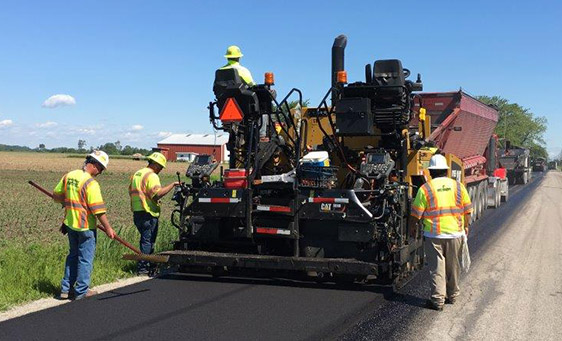Experience the Difference: Hot Mix Asphalt Paving for Regrading Projects
Experience the Difference: Hot Mix Asphalt Paving for Regrading Projects
Blog Article
Opening the Secrets of Hot Mix Asphalt Modern Technology
Discovering the midsts of hot mix asphalt technology reveals a globe where specific formulas and precise procedures converge to form our roads and framework. The blend of accumulations, binders, and fillers isn't merely a construction job however a tactical orchestration of resilience and performance.
Significance of Hot Mix Asphalt
Hot Mix Asphalt plays a critical function in modern framework growth due to its durability and cost-effectiveness. As one of the most commonly made use of paving product for roads, highways, and parking area, Warm Mix Asphalt uses a series of advantages that add to its value in construction tasks. One essential benefit is its capacity to endure hefty website traffic tons and rough weather, offering a reliable and resilient surface for transportation networks. In Addition, Warm Mix Asphalt is cost-effective in both preliminary building and lasting upkeep, making it a preferred choice for numerous facilities jobs.
The longevity of Warm Mix Asphalt stems from its composition, which consists of accumulations, binder, and filler materials that are meticulously chosen and mixed to fulfill particular efficiency demands. Overall, the relevance of Hot Mix Asphalt in infrastructure advancement can not be understated, as it proceeds to be a cornerstone of modern-day building techniques.
Parts of Asphalt Mixes
The composition of asphalt blends is composed of carefully chosen aggregates, binder, and filler products that are critical for achieving particular efficiency demands. Aggregates are the main part of asphalt blends, providing strength and stability. The binder, normally asphalt or asphalt concrete, holds the accumulations together and supplies versatility and durability to the mix.
The combination and proportion of these components play a significant role in identifying the high quality and performance of the asphalt mix. Engineers very carefully make the mix to fulfill details needs, taking into consideration factors like traffic volume, climate conditions, and sidewalk life-span. Appropriate selection and harmonizing of accumulations, binder, and fillers are essential for developing durable, lasting asphalt sidewalks.
Mixing and Production Strategies
:max_bytes(150000):strip_icc()/low-section-of-man-working-758486719-59da6d0a054ad90010617854.jpg)
As soon as the accumulations are picked, the binder, often asphalt cement, is added to bind the materials together. The binder's high quality and quantity dramatically influence the mix's resistance, adaptability, and toughness to ecological aspects. Furthermore, fillers like hydrated lime or Rose city concrete may be integrated to enhance specific characteristics of the asphalt mix, such as its workability or moisture resistance.
Throughout manufacturing, the aggregates and binder are heated up, commonly in between 250-325 ° F(121-163 ° C ), to assist in mixing and ensure proper layer of the accumulations. The blending process has to be thorough to attain an uniform mix that promotes the wanted efficiency qualities of the asphalt. Various strategies, such as batch mixing or drum blending, are employed to attain premium and consistent asphalt blends for building projects.
Variables Impacting Asphalt Efficiency
Aspects affecting asphalt performance include a range of variables that affect the durability, durability, and total top quality of asphalt pavements. One crucial variable is the quality of materials utilized in the asphalt mix.

Environmental conditions additionally influence asphalt performance. Temperature level variations, dampness infiltration, and website traffic loads can all influence the structural stability of the sidewalk. Design factors to consider, such as sidewalk thickness and water drainage, are vital in ensuring the long-lasting efficiency of the asphalt pavement. By very carefully considering these designers, variables and professionals can maximize asphalt efficiency and enhance the life span of sidewalks.
Sustainable Practices in Asphalt Technology

WMA enables for the production and positioning of asphalt blends at lower temperature levels compared to standard hot-mix asphalt, resulting in decreased power consumption and greenhouse gas exhausts. The use of porous asphalt mixes can aid alleviate stormwater drainage problems by permitting water to penetrate through the sidewalk and into the ground, advertising natural water filtering and reenergize procedures.
Final Thought
Finally, hot mix asphalt innovation plays a regrading crucial duty in modern-day framework development due to its toughness and cost-effectiveness. By carefully stabilizing components, employing proper blending strategies, and considering various factors, designers can create high-quality asphalt mixes that withstand heavy traffic lots and rough climate problems. Welcoming lasting methods, such as using recycled materials and warm-mix technologies, additionally improves the environmental friendliness of asphalt technology.
Blending and production techniques in warm mix asphalt modern technology include the accurate combination and handling of aggregates, binder, and fillers to create a high-performance and sturdy asphalt mix.Aspects influencing asphalt performance incorporate a variety of variables that impact the durability, long life, and general quality of asphalt sidewalks. Sustainable techniques in asphalt innovation encompass numerous efforts aimed at minimizing the environmental influence of asphalt production and paving procedures. By integrating reclaimed asphalt sidewalk (RAP) and recycled asphalt shingles (RAS) right into new asphalt blends, the market can considerably reduce the usage of raw materials and power, while also lowering garbage dump waste.
WMA allows for the manufacturing and positioning of asphalt mixes at reduced visit here temperatures contrasted to traditional hot-mix asphalt, resulting in minimized energy usage and greenhouse gas emissions.
Report this page